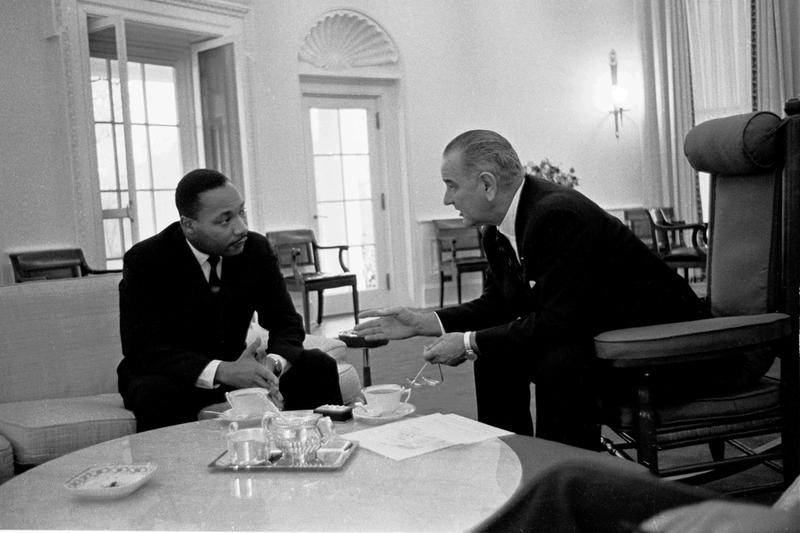When the Voting Rights Act was signed into law by President Lyndon Johnson on August 6, 1965, a new era began in the United States. With a stroke of his pen, Johnson struck down discriminatory voting practices that had been adopted — primarily in Southern states — to disenfranchise African Americans.
Those practices, many dating back to the end of the U.S. Civil War in 1865, included the imposition of literacy tests and poll taxes that often-blocked Black citizens from exercising their right to vote, as guaranteed under the 15th Amendment to the U.S. Constitution. Following on the heels of the Civil Rights Act of 1964, which outlawed discrimination based on race, colour, religion, sex or national origin, the Voting Rights Act of 1965 helped to solidify the gains of the U.S. civil rights movement.
Johnson was a Democrat (whose party had once been opposed to civil rights and political rights for African Americans) and a Southerner from Texas, yet he “recognized the continuing obstacles to Black Southerners’ participation in political life even as he signed the Civil Rights Act in early June 1964,” said James Ralph, a professor of history at Middlebury College in Vermont who specializes in the civil rights era.
Organisations such as the Southern Christian Leadership Conference (SCLC) and the Student Nonviolent Coordinating Committee (SNCC) launched Black voter registration drives, but met fierce resistance. Then, on February 18, 1965, a demonstration organized by the SCLC in Marion, Alabama, was attacked by segregationists. In the ensuing chaos, a demonstrator named Jimmie Lee Jackson was fatally shot by a state trooper.
In response, Martin Luther King Jr. and other civil rights activists planned three protest marches — collectively known as the “Selma campaign” — along the 54-mile (87-kilometer) highway from Selma, Alabama, to the state capital, Montgomery. On Sunday, March 7, Hosea Williams of the SCLC and John Lewis (who would later be elected to the U.S. Congress) of the SNCC crossed the Edmund Pettus Bridge in Selma, Alabama, leading a group of 600 marchers.
Police, using billy clubs and tear gas, brutally beat the peaceful marchers who were attempting to reach Montgomery. Many ran for their lives. A state trooper fractured Lewis’s skull and he suffered from a resulting concussion.
Reporters, photographers and TV cameras captured the episode, dubbed “Bloody Sunday.” A shocked nation was stirred into action, and Americans urged their elected representatives to crack down on the South’s regime of racial violence and to end voting discrimination, Ralph said.
On March 15, Johnson responded forcefully to events in Selma, Ralph said. In a nationally televised address, the president announced that his administration would introduce legislation to protect Southern Black people’s right to vote. Moreover, Ralph said, Johnson “directly aligned the federal government behind the cause of freedom in Selma when he concluded his remarks by embracing the words of the civil rights movement, saying, ‘And … we … shall … overcome.'”
Johnson and King did not always agree on how to cause change, “but from 1963 to 1965, they saw one another as critical partners in advancing civil rights,” Ralph said. The Voting Rights Act, sometimes called a “Second Emancipation” (a reference to President Abraham Lincoln’s Emancipation Proclamation of 1863), transformed the United States.
Next to the sweeping Civil Rights Act of 1964, it is the most important legislative accomplishment of the civil rights movement, Ralph said. “The disenfranchisement of Black Southerners was one of the main vehicles initiating and sustaining” the era of racial segregation in the American South.
The act established federal oversight of jurisdictions with problematic histories of racial discrimination. Those jurisdictions (mostly in the South) were prohibited from enacting any changes to their election laws without review and pre-clearance from the U.S. Department of Justice. It also was the first of several laws securing the rights of African Americans with disabilities and others with disabilities to vote at accessible polling places.
In 2013, the U.S. Supreme Court heard a case called Shelby County v. Holder and ultimately ruled that one of the Voting Rights Act’s provisions — Section 4 — was unconstitutional, because its formula for identifying “problematic jurisdictions” was out of date.
The legacy of the Voting Rights Act, which has been renewed and amended five times by Congress since 1965, is not easy to summarize. But, Ralph said, “there is consensus that it has been the key to greater African American participation in elections in Southern states and to the remarkable increase in the number of African American officeholders.”
In 1964, there were two African American members of the U.S. Congress, according to the Congressional Research Service. Today, more than one in five members of the U.S. House of Representatives and the U.S. Senate belong to racial or ethnic minority groups, making the 116th Congress the most diverse in U.S. history.











